Fèlsina
by
Kathy and Terry Sullivan
Summary: A visit to Fèlsina provides visitors with the opportunity to taste three or four wines and several tastings of their special olive oil. Allow plenty of time to enjoy the tastings. There is also time to learn about what makes the olive oil special at Fèlsina. The emphasis here is quality of wine and in order to produce quality wine, the grape yield from the vineyards is lower than those permitted by the Chianti Classico rules.
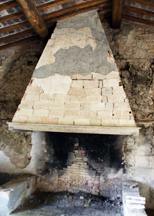 In the distance we saw a large farmhouse set away from the road high up on a hillside, before we arrived at Fèlsina. After reaching the winery, we learned the house we had seen was actually on the property of Fèlsina. The house is currently in disrepair but the owners are hoping to restore the house in the future. The first occupants of the house were Monks followed by farmers. The earliest document from the house is dated 1142.
In the distance we saw a large farmhouse set away from the road high up on a hillside, before we arrived at Fèlsina. After reaching the winery, we learned the house we had seen was actually on the property of Fèlsina. The house is currently in disrepair but the owners are hoping to restore the house in the future. The first occupants of the house were Monks followed by farmers. The earliest document from the house is dated 1142.
The Fèlsina property is comprised of eleven farmhouse properties. The property now consists of 485 hectares (almost 1200 acres) of which 89 hectares (220 acres) are vineyards. The “new” buildings were constructed in the 18th century. The wine cellar is of the 17th century. In 1966, Domenico Poggiali purchased the property and began the start of new vineyards and wine cellars.
We met Catherine Leiner at the winery and she graciously gave us her attention, answering all of our questions, escorting us around the property and even allowing us to see olive oil produced.
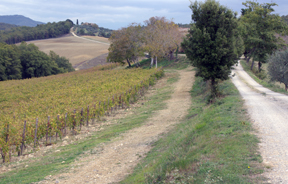
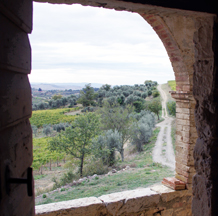 As we toured the property, Catherine pointed out Sangiovese grapes on both sides of the dirt road. Some people say there is a difference between the wines made from the Sangiovese grapes on each side of the road. Grapevines on the left side of the road are in the Chianti Classico appellation zone while those on the right side of the road are in the Chianti Colli Senesi appellation. Recently vineyard workers pruned olive trees and as in the case of grapes, the pruning late in the year enhances the flavor of the fruit. Staff heavily prune the olive trees early in the year - February and March. We were able to visit the old farmhouse and looked out over the many vineyards, seeing the rolling hills of the Chianti region in the distance. A wind sometimes comes down and enhances the grapes. Sometimes one can smell a hint of the Tyrrenhian Sea in the winds sweeping gently over the vineyards.
As we toured the property, Catherine pointed out Sangiovese grapes on both sides of the dirt road. Some people say there is a difference between the wines made from the Sangiovese grapes on each side of the road. Grapevines on the left side of the road are in the Chianti Classico appellation zone while those on the right side of the road are in the Chianti Colli Senesi appellation. Recently vineyard workers pruned olive trees and as in the case of grapes, the pruning late in the year enhances the flavor of the fruit. Staff heavily prune the olive trees early in the year - February and March. We were able to visit the old farmhouse and looked out over the many vineyards, seeing the rolling hills of the Chianti region in the distance. A wind sometimes comes down and enhances the grapes. Sometimes one can smell a hint of the Tyrrenhian Sea in the winds sweeping gently over the vineyards.
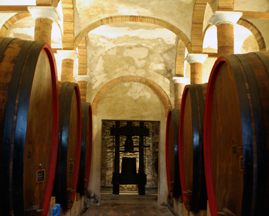
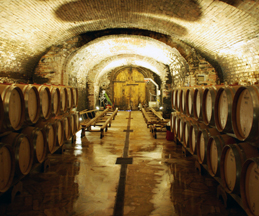 After our tour of the old farmhouse and vineyards, we went to the wine cellars in a building dating from the 17th century. Large wood tanks aging wine flank the sides of a room. Turning a corner more large oak tanks were resting. A number of French barriques were in a temperature-controlled room while others were in a different room.
After our tour of the old farmhouse and vineyards, we went to the wine cellars in a building dating from the 17th century. Large wood tanks aging wine flank the sides of a room. Turning a corner more large oak tanks were resting. A number of French barriques were in a temperature-controlled room while others were in a different room.
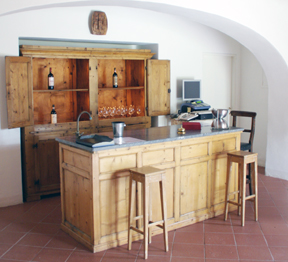
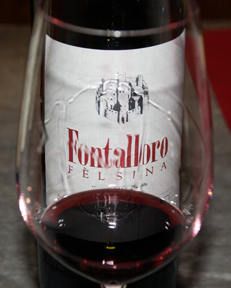 The tasting room, in another building, has a small marble counter and a pine display case behind the counter. On the counter is a book with plastic sleeves holding detailed information about each wine available at the winery. The floor is of 12 inch red ceramic squares. On the right side of the room is a long counter that has several different olive oil bottles with small plastic cups available for tasting the olive oil. In a back corner is a piano.
The tasting room, in another building, has a small marble counter and a pine display case behind the counter. On the counter is a book with plastic sleeves holding detailed information about each wine available at the winery. The floor is of 12 inch red ceramic squares. On the right side of the room is a long counter that has several different olive oil bottles with small plastic cups available for tasting the olive oil. In a back corner is a piano.
A typical wine tasting consists of a wine cellar tour, four to five wines to taste with Riedel stemware and olive oil tasting. We tasted wines including Sauvignon Blanc 2005 IGT. This was a small production of 7000 bottles. It had a fruit forward taste and was crisp. It was produced from grapes from the Castello di Farnetella vineyard. The Chianti Classico 2005 DOCG was produced from 100% Sangiovese grapes. It was a dark ruby red. It had the taste of dark cherries and spices. The Chianti Classico 2004 DOCG Riserva was also 100% Sangiovese and was darker ruby red with spices and dark red fruit taste. The Rancia Chianti Classico Riserva DOCG was100% Sangiovese, aged in French oak. It was an opaque ruby red color and tasted like spices and dark red fruit. The Fontalloro 2004 IGT was a blend of Sangiovese from three vineyards and is an opaque ruby red.
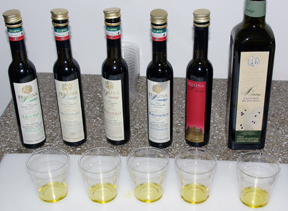 After the wine tasting, we tasted olive oil. Fèlsina uses a special process, Veronelli’s Method to produce single-varietal olive oil. This process promotes outstanding taste and is a healthy olive oil. On the day of our visit, a single-varietal olive oil was pressed. We observed the process and were amazed at the similarities to wine making. The olives were placed into a machine that separated the olives from stems and leaves. The next machine separated the pit from the olive and another machine extracted the oil. The oil was then pumped into stainless steel tanks until ready to bottle.
After the wine tasting, we tasted olive oil. Fèlsina uses a special process, Veronelli’s Method to produce single-varietal olive oil. This process promotes outstanding taste and is a healthy olive oil. On the day of our visit, a single-varietal olive oil was pressed. We observed the process and were amazed at the similarities to wine making. The olives were placed into a machine that separated the olives from stems and leaves. The next machine separated the pit from the olive and another machine extracted the oil. The oil was then pumped into stainless steel tanks until ready to bottle.
We tasted the Leccino, Pendolino, Moraiolo and Raggiolo olive oils. They had a green apple nose. Leccino had a mild flavor and as the tasting progressed the olive oil had a stronger spice taste. The fifth olive oil was a blend of olive oils.
Today Fèlsina and Castello di Farnetella produce between 750,000 and 800,000 bottles of wine (almost 67,000 cases) exporting 65% to the foreign market and 35% to Italy. If you enjoy olive oil and quality wine, this is definitely a good stop for you to make. While you are visiting, enjoy the wine tasting, olive oil tasting and a tour of the 17th century wine cellars.
GPS N 43° 20.975 E 011° 30.053 Elevation 341
Visit these tour operators that partner with Wine Trail Traveler.
 |
||||
|
Spain and Portugal |
SmoothRed London, England, United Kingdom |
